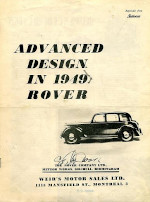
ROVER 'P3'
A New Development
1948 - 1949
The ROVER series 'P3' with the models '60' and '75' was ROVER's intermediate station into the modern age.
Predecessor
Predecessor is the post-war P2, continuation of the pre-war P2:
Post War P2.
Successor
Its successor will be a vehicle that is initially regarded as 'too American':
ROVER P4.
Although at first glance one hardly notices a difference to the ROVER series 'P2', the 'P3' is a completely new development. ROVER describes this development in an advertisment for the 'P3' as follows:
One new chassis, Two new engines, Two new bodies.
There is basically nothing to add.
In the 1948 catalogue, Spencer Bernau Wilks, General Director of ROVER since 1929, addresses sales partners and dealers:

In fact, it is difficult - not only for ROVER - to produce and sell vehicles in the post-war period. The production suffers from material shortages, the distribution groans under an enormously high sales tax. The 'P3' has been in development since 1945 at the latest, many variants of the body design have been tried out. In view of the developments in the USA, it may come as a surprise that Rover opted for a very conventional body for the 'P3'. But one knows that the group of buyers who can afford the car is very traditional - in this respect a clever move. It's a transitional development that combines new technology with conventional looks.
ROVER distinguishes between the two body shapes by the number of side windows: 'Six Light Saloon' with six side windows and 'Four Light Saloon' with four side windows. The designation 'Sports Saloon' for the 4-window version is no longer used.
Both body shapes are offered with the new four-cylinder engine - as model '60' - and with the new six-cylinder engine - as '75' - in identical equipment.
 Radiator emblem ROVER P3 '60'
Radiator emblem ROVER P3 '60' Radiator emblem ROVER P3 '75'
Radiator emblem ROVER P3 '75'| Sources | |||||||
|---|---|---|---|---|---|---|---|
 | Reprint 'The Autocar' 1949 |
 | Rover P3 Brochure Genova Salon 1948 |
 | Rover P3 Catalogue 1948 |
 | Rover Announce... Reprint 'The Motor' Februar 1948 |
© 2021-2026 by ROVER - Passion / Michael-Peter Börsig

 Deutsch
Deutsch